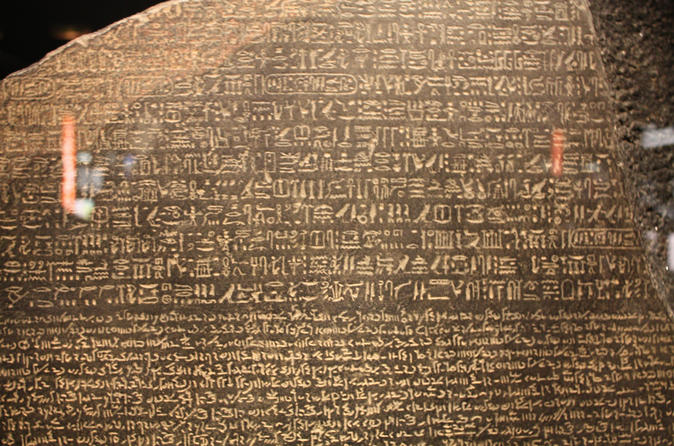Rosetta stone Discovery
In July 1799 A.D. and by good chance, one of the French troops under the command of the officer Bouchard found a stone of black basalt known as Rosetta stone bearing an inscription in Hieroglyphic, Demotic and Greek writing.
This stone was inscribed by the priests of Memphis during the reign of Ptolemy V in 196 B.C. to eternalize the memory of his coronation.
They described him as a king who loved his people and bestowed much upon Egypt and therefore they varied the celebrations held for him in the temples as sort of gratitude.
They were not aware that they had unintentionally woven for us the thread by which the mystery of the ancient Egyptian language was deciphered.
Champollion discovered that the oval shapes in the Hieroglyphics, now known as cartouches include the names of the kings and queens and by comparing them with the Greek text, the names of Ptolemy and Cleopatra were recognized.
That was the start followed by solving the rest of words.
The stone fell to the share of the British Museum in London after the French forces delivered it unwillingly to Britain by virtue of a treaty concluded between them.
The E.A.O. has exhibited a cast of it in the citadel after being restored.
The Rosetta Stone Facts
Rosetta is distinguished by its national history and unique decorative and architectural heritage and of curse Rosetta stone.
It is considered a large open museum for the Islamic architecture and that is clear in its religious and civil buildings (houses and mosques).
This artistic monumental group does not exist in any other city except Cairo which most of its buildings date back to the Ottoman period during the 18th and 19th centuries A.D. except its famous Citadel and the remains of its wall which date to the Mameluke period.
Rosetta History and Location Before Rosetta Stone
This city lies on the western bank of Rosetta branch where the River Nile flows into the Mediterranean Sea at a distance of 65 km. north east of Alexandria.
Its location had been of great strategic importance since the most ancient pharaonic periods, as there was a big temple for Amoun belonging to the new kingdom.
In the Greek period, the area where Rosetta lies was called Bolobtine and the River Nile branch which it commands was called the Bolbitine branch as well.
In 641 A.D. when Amr Ibn al-Ass conquered Egypt, Rosetta was known by this name, but it was not then an important port due to the foundation of Alexandria city in 331 B.C. that converted the commerce from the Bolbitine branch to the Kanoby one (Abou Kir).
The foundation of Cairo in 969 A.D. weakened the commercial position of Alexandria and Rosetta became once more an important city, the matter that affected deeply its growth and flourishment.
Since the 12th c.A.D. Rosetta harbor received more care and the rulers came to it to check its fortifications by themselves.
In 1472 A.D. Sultan Qaitbay built there a citadel surrounded by a rampart for defense and in 1516 A.D. Sultan al-Ghori built a wall for the city on the sea shore in addition to towers for protecting the harbor.
“The Cape of Good Hope” discovery in the 15th c.A.D. led to the declination of Rosetta after converting the commerce to South Africa.
In 1517 A.D. when the Ottoman conquered Egypt, Rosetta became the most important harbor reaching then the acme of its architectural flourishment, thanks to the mosques, houses, bathhouses, mills, citadels and gates built there.
During the French campaign to Egypt the city gained great fame after the discovery of Rosetta stone in Qaitbay citadel.
This famous stone was the key of deciphering the mystery of the ancient Egyptian language and it is now exhibited in the British Museum of London.
The city started to decline again after digging al-Mahmoudiya stream in 1819 A.D. and sailing to Alexandria across it.
Rosetta lived bloody battles during the recent period, the most important of which was that against the English invasion under the command of Fraizer in 1807 A.D. Ali Bey al-Salankly, the governor of the city then, played a great role in the brave defense till the victory.






